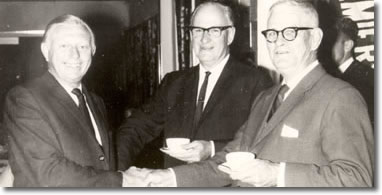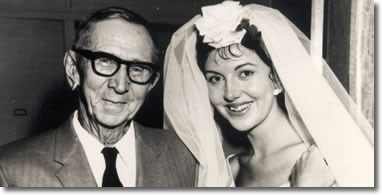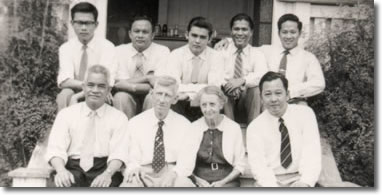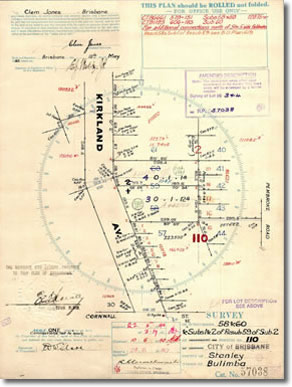Clem Jones: surveyor and visionary

Surveying was the first stage of Clem Jones' career, providing a strong grounding for his further major accomplishments. There was a natural progression from surveying to town planning, and on to his most well-known achievement as Lord Mayor of Brisbane from 1961 to 1975. A number of Brisbane landmarks are named in his honour such as the Clem Jones Tunnel and the Clem Jones Centre in Carina.

Family connections in surveying
Clem Jones was born at Ipswich on 16 January 1918, the first son of Elsie Mary (nee Cleminson) and Edward Walter Jones. He was educated at the Church of England Grammar School in Brisbane.
Surveying was in his blood. Clem's uncle on his mother's side, Charlie Cleminson, was a prominent Queensland surveyor.

Another uncle, Arthur Cleminson, was also a surveyor and became the Surveyor-General of Lagos, Nigeria. The surveying connections do not end there.
Clem's father, Edward Walter Jones (Teddo), was a brilliant and much loved mathematician who taught surveying computations to surveying students in one of his roles.
Training to become a surveyor
To become a surveyor in the 1930s, you were articled (apprenticed) to a private or government surveyor to gain practical field experience in as many fields of surveying as possible. In your own time after a hard day's work you studied for, sat and had to pass Australian Surveyors Board subjects (e.g. astronomy, valuations, geology, town planning, and surveying practice).
The last step was to sit for the final Australian Surveyors Board examination. If you passed you were granted automatic registration as an authorised surveyor.

Early surveying career
At the age of 17, on 1 March 1935, Clem started work in Brisbane as a cadet surveyor articled to Ronald Alison McInnis, who was one of Australia's leading town planners. When McInnis took up a job as a town planner for the Brisbane City Council, he handed over his surveying practice to another very prominent Queensland surveyor, John Stevenson, who continued Clem's training.
Clem travelled to Victoria in 1940 to sit for the final Australian Surveyors Board examination, which he passed. He was registered in Queensland as an authorised surveyor on 30 April 1940. Being an authorised surveyor allowed him to carry out crown land and real property surveys.
Surveying experience
Clem was prominent in the surveying field. In 1940 at the young age of 22 years, he started his own surveying practice which was later incorporated as Clem Jones Pty Ltd. Within 10 years, Clem had created an innovative surveying business and was one of the leading practitioners of this period. The business provided a wide range of services including consultancy, town planning, subdivisional design, cadastral and engineering surveys and drafting. Clem's wife, Sylvia, was the head of the drafting department, playing an important role in the firm.
By 1954 his business was one of the largest surveying practices in Australia. During this time, his practice expanded with branches in Dalby, Miles, Chinchilla, Roma, Rockhampton, Gladstone and Maryborough. As well as conducting surveys for private clients, his company conducted a large number of surveys for local authorities (e.g. Bauhinia, Rockhampton, and Maryborough). This work included surveys for an aerodrome, racecourse, dam site, and a road to a port. In 1955 when he was just 37 years old, he sold his business to pursue other interests. He would later return to surveying in 1984.
Surveys
A list of surveys linked to Clem Jones and his firm shows that they produced an enormous volume of work with over 1,550 surveys up to 1955 when he sold the business. The majority were surveys of freehold properties though some of the surveys were done for the government. These numbers do not include the engineering type surveys that his firm would have carried out during this period. Surveys extended all over Queensland including Brisbane, Redcliffe, Cleveland, Rockhampton, Gladstone, Maryborough, Longreach, Roma, Toowoomba, Tamborine, Urangan and Yeppoon. This supports the prominence and importance of Clem and his surveying efforts.

His prominence and expertise were acknowledged when the Courier Mail in 1952 sought his and another's opinion to examine alternatives to the then method of land valuation.
Read the article, 'Two city land experts outline a new system' in the Sunday Mail, Sunday 23 November 1952, p. 5.
Challenges of surveying
Some of the challenges faced by Clem in his surveying career were captured in a humorous 1954 newspaper article in the Newcastle Sun titled 'Clem Jones fights with famine'. The author, George Blaikie, suggested that 'the grim lines that mark the dour visage of Mr. Clem Jones, prominent Brisbane surveyor, are not the products of age or indulgence', but rather lack of food over a 6 day period when he and his survey team were at Many Peaks (approximately 42 km north-east of Monto) for a 1943 surveying job. This job was at the request of the Commonwealth Government to assist in the war effort.
Read the article, 'Clem Jones fights with famine' in the Newcastle Sun, Wednesday 3 February 1954, p. 7.
Commitment to the surveying profession
Clem had a strong commitment to the surveying profession. At 18 he became acting secretary of the Queensland Institute of Surveyors for 18 months. At the age of 22 he was writing letters to the editor of the Courier Mail as Honorary Secretary of the Queensland Institute of Surveyors expressing strong opinions on the need for men with technical knowledge to be given a chance to display administrative ability within the Queensland Public Service.
Read the letter to the editor, 'Give technical men chance' in the Courier Mail, Tuesday 17 September 1940, p. 4.
He was formally admitted to membership of the Institute in 1940. He went on to serve as the editor of the inaugural Queensland Surveyors Bulletin. For the Institute, he was the Queensland Representative at the 1950 British Commonwealth and USA Survey Conference. He gave of his time and was always willing to get involved. His commitment was recognised when he was elected an Honorary Fellow by the Institute of Surveyors (Australia) in 2002. This is the highest honour available to Australian surveyors and few are awarded. It is a great honour.
Town planning
Examples of his passion and interest in town planning were visible from a very early stage of his surveying career. For example in 1946, he gave an address on town planning to a Rotary group at Rockhampton and in 1947 to the Gatton Shire Councillors. His words from these talks were prophetic and they resonate with town planning today.
'A town-planning scheme aims to undo past mistakes. We cannot know what the future holds, or how large a town may grow, but we can, and should, provide by all means within our power to make the growth orderly. It is a task of the planner to provide the channels along which the ship of progress may sail'.
Read the full article, 'Task of town planner' in the Queensland Times, Thursday 13 March 1947, p. 2.
Legacy
Clem Jones died at the age of 89 on the 15 December 2007. With his strong commitment to the state of Queensland and those around him, he left a strong legacy. This legacy was accomplished with his trademark of driving energy.
Reference
The Clem Jones Group. (2014). Dr Clem Jones AO.
Related links
- You can access our museum collections, services and research resources.
- View the images of items held in the Clem Jones collection at the Museum of Lands, Mapping and Surveying.


